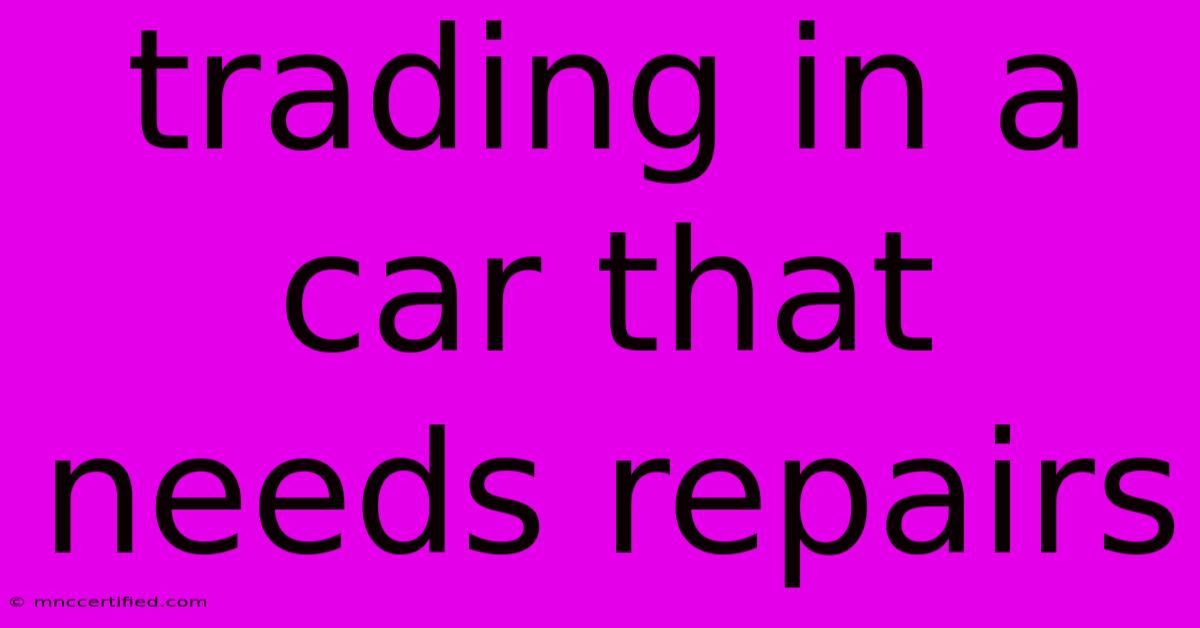Trading In A Car That Needs Repairs

Table of Contents
Trading in a Car That Needs Repairs: A Guide to Getting the Best Deal
You've decided it's time for a new car, but there's a problem: your current vehicle needs repairs. Maybe the engine is sputtering, the transmission is slipping, or the air conditioning is on the fritz. You might wonder if you can still trade it in and if it's worth the hassle. The good news is, yes, you can often trade in a car that needs repairs, but understanding the process and potential challenges is key to getting the best deal.
Assess the Severity of the Repairs
The first step is to realistically assess the severity of the repairs. Is it a minor issue that can be fixed for a few hundred dollars, or are we talking about major engine work or a complete transmission overhaul? The cost of repairs will directly influence the trade-in value.
Research the Market Value of Your Car
Before approaching a dealership, research the market value of your car. Use online tools like Kelley Blue Book or Edmunds to get an estimate based on your car's year, make, model, mileage, and condition. Remember, these values are for cars in good working order, so adjust your expectations accordingly.
Be Transparent with the Dealership
Honesty is the best policy when dealing with a dealership. Disclose all known issues with your car upfront. This will prevent surprises and potentially damage your credibility. Be prepared to provide documentation of any repairs or maintenance records.
Consider Getting the Repairs Done
In some cases, it may be advantageous to get the repairs done before trading in your car. This can significantly increase the trade-in value. However, weigh the cost of repairs against the potential increase in value. If the repairs are extensive and costly, it might be more financially beneficial to sell the car privately after fixing the major issues.
Negotiate Strategically
Be prepared to negotiate the trade-in value. Dealerships may initially offer a lowball price, especially for a car needing repairs. Use your research and the estimated value of your car in good condition as leverage. Be willing to walk away if the offer is too low.
Understand the Potential Downsides
Trading in a car with repairs can come with some downsides:
- Lower Trade-in Value: You'll likely get a significantly lower trade-in value compared to a car in good condition.
- Potential Hidden Costs: The dealership might discover additional problems during their inspection, which could lead to further deductions from the trade-in value.
- Longer Negotiation Process: Expect a more lengthy negotiation process as the dealership assesses the repairs and determines the trade-in value.
Alternatives to Trading In
If you're unhappy with the dealership's trade-in offer, consider these alternatives:
- Sell Privately: This gives you more control over the selling price and allows you to disclose any issues to potential buyers.
- Trade for Parts: If your car has significant damage, you might consider selling it for parts.
- Donate Your Car: Some charities accept car donations, and you may receive a tax deduction.
Conclusion
Trading in a car that needs repairs is possible, but it requires careful consideration and preparation. Assess the severity of the repairs, research the market value, be upfront with the dealership, and be prepared to negotiate. Remember, you have options, and you don't have to settle for an unfair deal. By understanding the process and considering the alternatives, you can make the best decision for your situation.

Thank you for visiting our website wich cover about Trading In A Car That Needs Repairs. We hope the information provided has been useful to you. Feel free to contact us if you have any questions or need further assistance. See you next time and dont miss to bookmark.
Featured Posts
-
Composite Bonding Before And After Small Teeth
Nov 14, 2024
-
Insurance Companies In Wooster Ohio
Nov 14, 2024
-
Whoopi Goldbergs Financial Woes Spark Backlash
Nov 14, 2024
-
Homebase Sale 2 000 Job Cuts Feared
Nov 14, 2024
-
Argentina Citizenship By Investment
Nov 14, 2024